Lady Bird, the solo writing and directing debut from actress Greta Gerwig, is a nerve-wracking, stomach-twisting, and ultimately heartwarming delight.
The film follows a year in the life of Lady Bird (Saoirse Ronan), a wanna-be rebel Catholic school student who yearns to outgrow her family home in Sacramento.
Plot-wise, the story of Lady Bird may sound thin on paper… but that’s the whole point: the film is about the tiny moments in our years that feel epic as we stitch them together into a life.
By revealing Lady Bird’s world through a series of episodic vignettes — much like how we experience real life — Gerwig rightly trusts that her audience won’t need a convoluted soap opera plot to grow invested in her characters’ emotional arcs. Instead, Gerwig invites you in, but she expects you to pay attention to the details along the way. Lady Bird relies on subtle inference the way most movies rely on clunky exposition.
This isn’t a surprise, given Gerwig’s acclaimed indie filmmaking history.
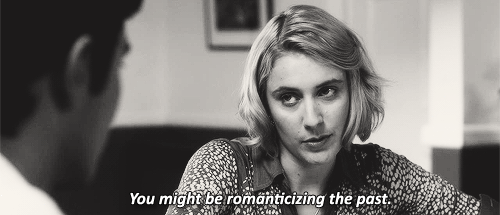
But nostalgia is such a lucrative hobby…
The first decade of Gerwig’s career was spent acting and collaborating with some of the best writers and directors in indepedent film. Her films with Joe Swanberg (Hannah Takes the Stairs), Jay and Mark Duplass (Baghead), Noah Baumbach (Greenberg, Frances Ha), and Whit Stillman (Damsels in Distress) helped to bridge the indie “mumblecore” scene into the Hollywood mainstream.
In many ways, Gerwig’s onscreen presence evolved the “manic pixie dream girl” archetype into something more relatable and tangible for the downbeat, introspective Millennial era. And now, Lady Bird seems to mark a new storytelling evolution, from mumblecore’s introspective ennui to a pragmatic hope in the possibilities of tomorrow.
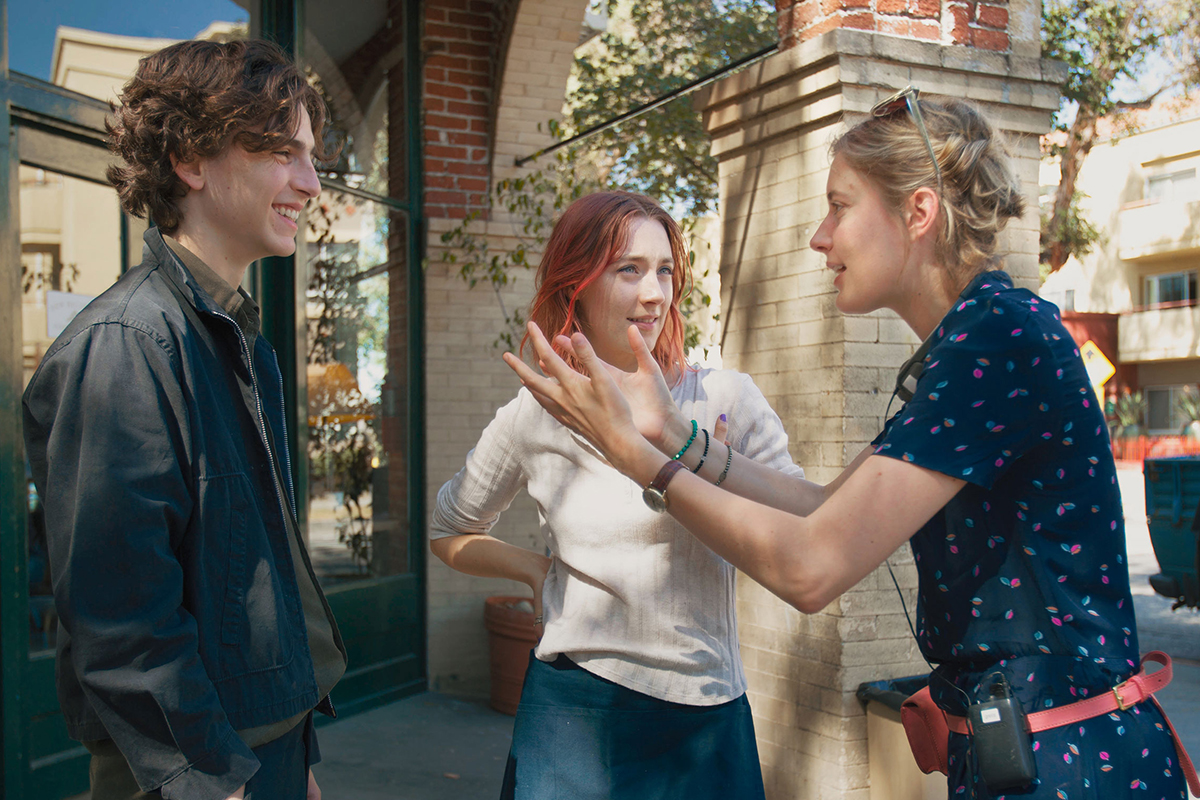
Greta Gerwig directing Timothee Chalamet and Saoirse Ronan in Lady Bird
When it comes to numbers, I’m a notoriously stingy critic, but Lady Bird is one of the rare films that I would rate a perfect 10.
In honor of this, let’s look at 10 of the best small moments in Lady Bird that prove just how confident and effective Greta Gerwig’s filmmaking and storytelling abilities already are after just her first solo feature.
(WARNING: Mild spoilers ahead for a film that doesn’t really have any secrets to ruin.)
10 Subtle Storytelling Tactics in Lady Bird
(And for what it’s worth, I actually had trouble narrowing this list down to ten.)
Body Language Does 90% of the Work
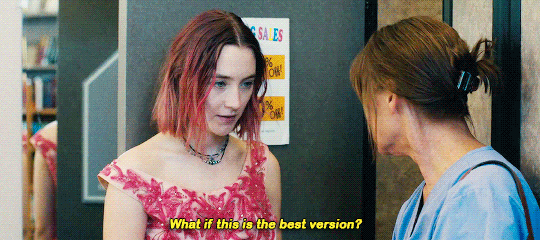
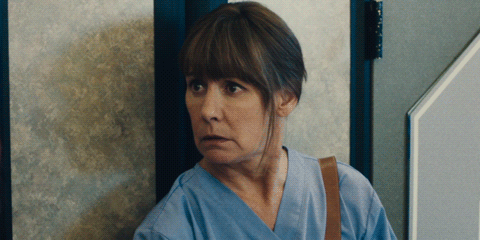
A fast-paced ensemble comedy doesn’t have a lot of time for backstory, so Gerwig wisely and successfully takes a calculated risk that I wish more directors had the confidence to try.
Instead of forced and unnatural exposition to set up the plot and relationships, Lady Bird trusts that we will infer what we don’t already know about these characters based on how they act toward each other. To accomplish this, Gerwig heavily relies on body language as a storytelling shortcut.
Thus, the unspoken histories between any two characters can be revealed in just a few motions. Gerwig manages to imply years’ worth of interactions between characters through posture and blocking, letting an eager attentiveness or an indifferent slouch show us what other films feel obliged to tell us. As an added bonus, we see the shifting balances of power between characters as their body language changes over time.
This is especially true for Lady Bird and her best friend Julie (Beanie Feldstein, who also stars in the extremely underrated Booksmart). They’re extremely expressive as they react to others throughout the film, so when their own friendship eventually fractures due to Lady Bird’s self-centered choices — and they start to see one another as something other than friends — their body language around each other starts to resemble a breakup.
Nailing the Nuances of a Romantic Crush
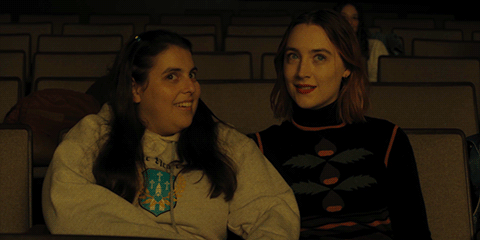
Oh myyyyy
Greta Gerwig seems to know that love is mostly how you feel when you’re with that person, and the self-image you construct around being someone who is loved.
As such, Lady Bird does a phenomenal job of depicting burgeoning romances via the body language of the characters as they realize how they see themselves is changing.
Influence through Minimalism
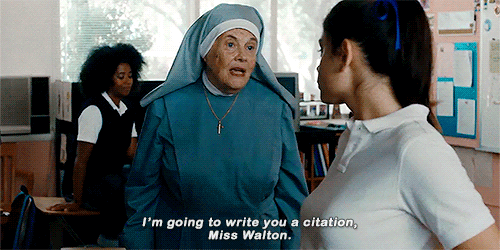
One of Lady Bird‘s most impressive delights is Gerwig’s ability to convey the inner lives of her characters with just a few broad strokes — a few words, an outfit, a movement, a look. Her choices are impressively economical: the film is barely 90 minutes long, but you feel as though you’ve gotten to know over a dozen characters quite well.
Take Sister Sarah Joan (Lois Smith). Although she only chastises Jenna (Odeya Rush) once onscreen for Jenna’s wardrobe improprieties, her body language lets us know that this isn’t the first time this has happened, nor will it be the last. It’s also the classic “I’m not mad, just disappointed” look.
And yet, when Lady Bird scores points with the more-popular Jenna by helping her “get revenge” on Sister Sarah Joan, we’re surprised to see this story beat take a twist: instead of getting Lady Bird in trouble, Sister Sarah Joan uses their encounter to connect with her in an unexpected way.
In other films, this could have been an entire comedic subplot. Here, it’s barely three scenes, but it upends our expectations, shifts the characters’ power dynamics, and serves the theme by leading Lady Bird (and us) into a new way of seeing the world.
Surprises Come in Layers
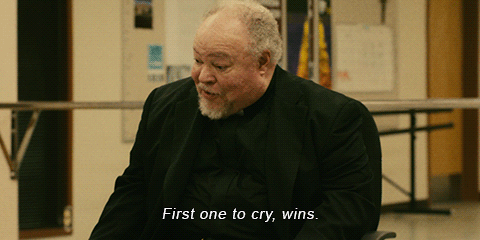
“Winning” is a matter of perspective
There’s not a single one-dimensional character in Lady Bird. Even the most minor recurring character is granted nuances that help define their inner war between who they want to be seen as and who they really are.
These dichotomies are often established through a surprising moment in which other characters (and, by extension, the audience) are invited to see someone in an unexpected light that reframes our expectations.
For example, during a montage of improv exercises for the theater class, Father Leviatch (Stephen McKinley Henderson, who may also look familiar as Thufir Hawat in the 2021 Dune) invites the students to practice crying on cue. Our first surprise is an offbeat punchline: Father Leviatch himself is the first one to cry, and uncontrollably at that.
But that punchline takes turns throughout the rest of the film, from comedy to catharsis, as we’re continually invited to see Father Leviatch in a new light — and all in just a few scenes.
The Happy-Sad Balance
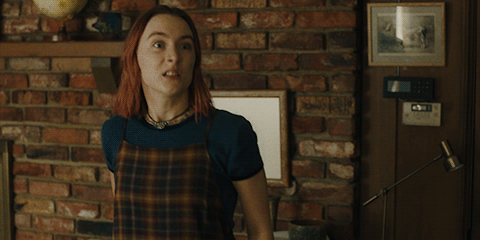
Mellow… that’s my style…
Lady Bird‘s insistence on showing multiple sides to every story has a bittersweet side effect: every upside comes with a down… and a bounce-back.
Every romantic high point sets up a low point… which sets up a new and different possible joy.
Every academic success comes with an asterisk… which creates new opportunities for growth.
Every personal bond feels more like Scotch tape than Gorilla Glue… which, over time, creates a cocoon instead of a direct link.
One of the best examples of this is Lady Bird’s theater debut. After a successful performance, the parents, teachers, and students happily mingle… but her best friend Julie’s crush on her math teacher craters when she’s introduced to his pregnant wife. Despondent, Julie sits down next to Father Leviatch, who’s downright miserable.
“They didn’t understand it,” he says of the happy parents, echoing the misunderstood vibe of every tortured artist. And thus, what should be an unqualified high point for these characters registers as a melancholy low instead.
Treating Sex as a Function Instead of an End Goal
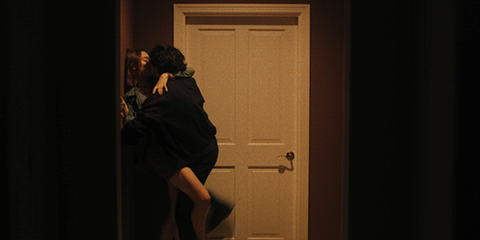
Crazy in love…
This being a high school coming-of-age story, there’s a heavy focus on love and sex.
Gerwig takes a refreshingly candid approach to these elements by balancing Lady Bird’s desire for romantic and sexual fulfillment with the reality of sex as a teenager: generally speaking, it’s not that great. So rather than a rom-com where the characters are defined by achieving their epic desires, Gerwig creates a facsimile of real life where characters crave storybook levels of desire but keep getting tripped up by love’s pedestrian mechanics.
That Dave Matthews Band Song
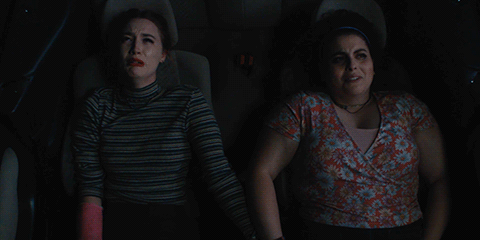
Crash into me bayyyybaaaaay
Lady Bird is unironically funny, which feels like a massive relief after several decades of culture-defining, irony-drenched satire.
Nowhere is this more apparent than in Lady Bird and Julie’s mutual emotional breakdown during the Dave Matthews Band’s “Crash,” which feels exactly like it should when you’re 17 and that kind of connection with someone else feels not just possible but deserved, and its perpetual elusiveness tears you apart.
When the song resurfaces in the film’s second half, it prompts Lady Bird to make a choice that’s so emotionally honest, it turns what could be a cliché moment into a character-defining masterstroke.
The Absence of a Villain (Mostly)

American Gothic 2.0
There is no class bully in Lady Bird.
There is no terrible boyfriend, no plastic mean girl, no iron-fisted teacher to present Lady Bird with her insurmountable obstacle.
Lady Bird thinks her mother is her enemy, but the film knows better. As anyone who’s old enough to have kids in school will realize, Lady Bird’s mother is doing the best she can with the cards they’ve been dealt. Does she make a few bad decisions? Sure, but what parent doesn’t?
No, the great irony of Lady Bird is that the closest thing the film has to a villain is… Lady Bird.
She’s a self-centered rebel without a cause who rejects everything she has because she wants something more… but she’s not quite sure what that should be, exactly. All she knows is that she’s ashamed of what she isn’t, and her insecurity manifests as passive-agression, rebellion, tantrums, projection, and lashing out at the friends and family whose approval she craves.
She wants the American dream without knowing why, and she’s not entirely sure that she’s smart enough to figure out an alternative.
In other words, Lady Bird is all of us.
And that means each of us is someone else’s almost-villain too, without even meaning to be.
Doors as Metaphors
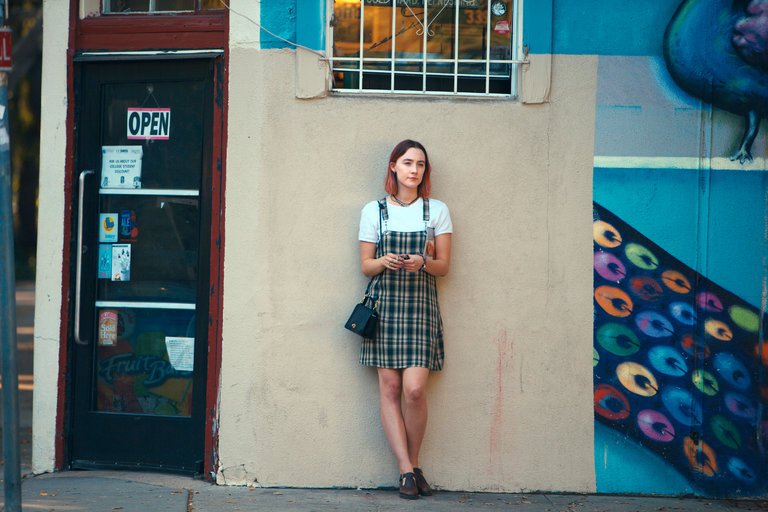
You know the day destroys the night
Part of me doesn’t want to overthink this. After all, the world is full of rooms, which therefore means it’s also full of doors by design.
But Lady Bird repeatedly uses doors as a visual cue to represent the claustrophobia that these characters feel trapped in. Likewise, their absence often signals that characters are free to make their own choices… for better or worse.
In the film’s first scene, Lady Bird gets so infuriated by a conversation with her mother that she literally hurls herself out of a moving car in protest. Our lesson? Lady Bird refuses to be caged by expectations and norms… and yet, at the same time, she craves the stability and validation they provide.
Her Sacramento high school features several open-air classrooms without doors. While passing one alone, Lady Bird seizes the opportunity to steal the class gradebook from an empty room, a move that signals both her independence and her unpredictable moral compass.
Her father always knocks before he enters her room, but her mother never does, signaling their different approaches to life, privacy, and authority. By comparison, her brother and his girlfriend sleep downstairs on the couch: no doors, no privacy. They’re living their post-collegiate lives in flux.
When Lady Bird discovers a troubling bottle of prescription pills in the bathroom, she barely has time to process what she’s seen before the door opens, smashing into the open drawer: an emotional block that no one has time to resolve.
In the film’s final minutes, Lady Bird feels called through a different open door, although she’s now able to come and go as she pleases. She’s free, but also looking for the newly-absent stability she’d been taking for granted.
In short: you don’t name a character and a movie Lady Bird without using rooms, doors, and boxes to signify that character’s simultaneous yearning to be both free and safe.
Speaking of which…
That Very Last Scene
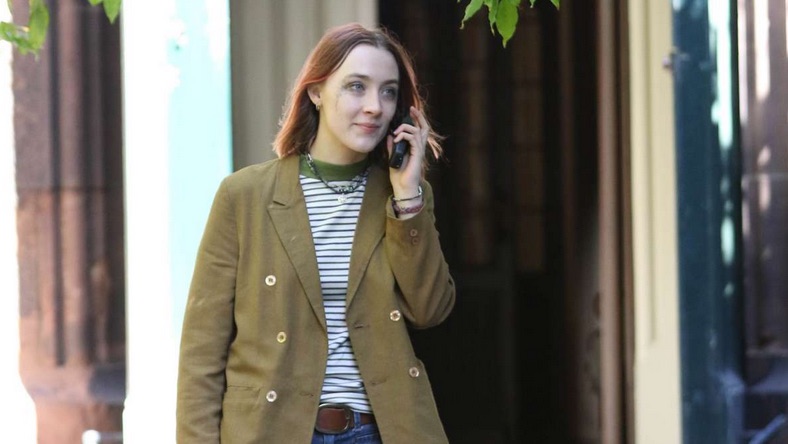
Can you hear me now?
Without giving away how the whole movie ends, I want to commend Greta Gerwig for two choices she makes in directing the film’s final scene.
First, Lady Bird rectifies its central theme (choosing how to define yourself) with its aesthetics. Lady Bird isn’t Catholic, but she is the product of a Catholic high school, and even non-believers in a faith can still find comfort and familiarity in those symbols and habits… which, in turn, highlights how much of who “we” are depends on what we absorb or reject along the way.
Second, Gerwig’s choice of closing frame is exceptional.
Most other filmmakers would have given us A Very Definitive Image to button up their theme. But Gerwig takes a different approach. She literally ends her movie mid-reaction, in a manner that every “how to direct for clarity” course would probably would flunk you for.
Instead of satisfying audience expectations, Lady Bird reminds us that life is always in transition.
And, like every other risk Lady Bird takes, it works.
If You Liked This Post…
You may also enjoy learning why The Queen’s Gambit is such smart visual storytelling… or how WandaVision questions its audience… or what happened when I watched Mamma Mia 2 without seeing the first one.
WandaVision’s Biggest Question Gets Deep: Who Are We, Really?
25 Reactions to Mamma Mia! Here We Go Again from a Guy Who Never Saw the Original
Want More? See My Top Storytelling Posts


1 Comment
Ruth · May 4, 2022 at 7:00 am
Thank you so much! You gave single-handedly saved my English grade! I haven’t seen half of these techniques and details mentioned in any other essays, really innovate and profound examination of an amazing film!!